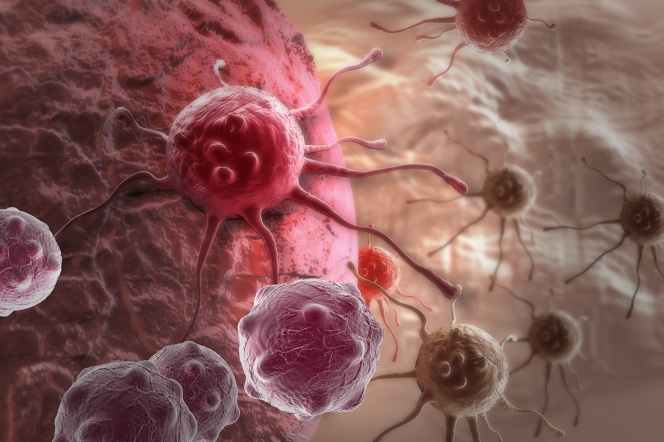Date added: 2022-10-12
Disruption of the NMD pathway in cancer cells. A step towards defeating cancer

Production of proteins in each cell can be encumbered with potential errors. There are many mechanisms in living organisms that minimize the formation of defective, undesirable proteins. One of these security mechanisms (the NMD pathway) controls the correctness of the messenger RNA (mRNA): breakdown of the abnormal mRNA occurs when a STOP codon is detected. The NMD mechanism prevents potential problems caused by defective proteins. Its job is to detect and destroy abnormal mRNA that could lead to the formation of abnormal proteins in the cell.
NMD is used by all cells, both healthy ones, where it limits the production of accidental, damaged proteins, and by cancer cells. It is in the latter that NMD is particularly active, making the cancer cells "invisible" to the human immune system, allowing them to multiply without restriction.
The team of Prof. Sławomir Makowiec, DSc together with Umesh Kalathiya, PhD and Prof. Theodor Hupp from the University of Gdańsk, conduct research aimed at blocking the NMD pathway in cancer cells, so that they become visible to the immune system and can be detected by it. The researchers obtained funding for their project from the National Science Center in the OPUS competition. The project is comprehensive and comprises many research tasks: the molecular modeling conducted by Umesh Kalathiya, PhD, allows to select the potential structures that meet the requirements of the NMD pathway inhibitor, these structures are physically obtained in the laboratory of Prof. Makowiec (become synthesized compounds), and then are biologically tested at the International Center for Cancer Vaccines Science of the University of Gdańsk.
Enable lymphocytes to act
– If such (cancer) cells are blocked in some way by the NMD pathway, they will start to produce damaged proteins, which will be detected by the immune system when getting on the surface of the cell membrane. Noticing a cancer cell and labeling it as "foreign" by the immune system is equivalent to destroying it later. For the patient, it simply means recovery, because no medicine is as effective as proper lymphocyte functioning – explains Prof. Makowiec – Even advanced cancer in the body, if recognized by the immune system, is degraded. Neoplasms use very good camouflage to function in the human body, and NMD simply helps them a lot.
Such a method would help to create a therapy that is targeted, effective and, above all, non-invasive for the patient.
– In order to deactivate a selected protein in cancer cells, we have to find a specific inhibitor for it, we can say "a stick in the spokes" for a given protein. Introducing such a molecule into a cancer cell causes a given protein cease to be active. It is possible, for example, to introduce another chemical compound in place of ATP - adenosine triphosphate, needed for the proper functioning of the protein, that strongly binds to the place where ATP should be properly located. Such a compound should fit like a key to the lock in the place of ATP binding. It would be best that this "key" remained permanently in the "lock". Then we say that our molecule has a greater affinity than the natural ligand.
From synthesis to therapy
The theory is simple, however finding a compound that effectively blocks a protein is a long and time-consuming process. Researchers are currently working on groups of several compounds selected on the basis of calculations. In total, there are several thousand structures with promising properties to be tested. This means using supercomputers for calculating interactions between the designed structures and the protein, physical synthesis of compounds, and subsequently laboratory tests on proteins alone – if any of the compounds proves to be effective, in the following stage also on cells.
At any stage, such a compound may turn out to be ineffective, despite the fact that in the calculations it proved to be appropriate. Even if cell research turns out to be successful, it is only 20 percent of the process that a compound must go through to form the basis of a new drug. What works extremely effectively in laboratory tests may turn out to be inappropriate in the target therapy - the drug may be too toxic, damaging e.g. the kidneys, interacting unpredictably at previous stages.
– Many promising compounds that were to effectively heal cancer, were impossible to apply in pharmacology. Therefore, we need to patiently search, test and check – says the researcher.
Verification of compounds that were promising at the stage of calculations, can prove them to be ineffective during protein and cell tests.
The project started in September 2020 and will last until September 2024. The researchers plan to test several thousand designed chemical compounds in silico. Several dozen of the best potential inhibitors of the NMD pathways will be synthetized.





